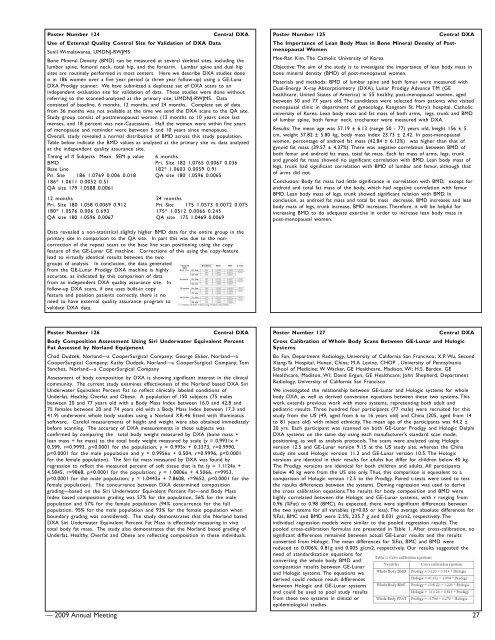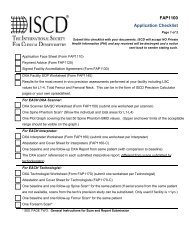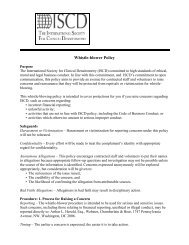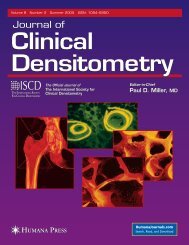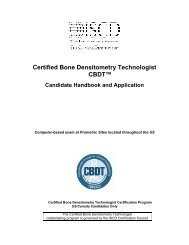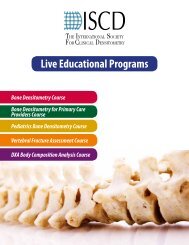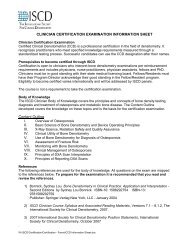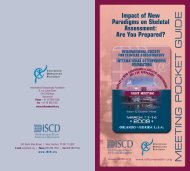Program Book and Abstracts - ISCD
Program Book and Abstracts - ISCD
Program Book and Abstracts - ISCD
Create successful ePaper yourself
Turn your PDF publications into a flip-book with our unique Google optimized e-Paper software.
Poster Number 124<br />
Central DXA<br />
Use of External Quality Control Site for Validation of DXA Data<br />
Sunil Wimalawansa, UMDNJ-RWJMS<br />
Bone Mineral Density (BMD) can be measured at several skeletal sites, including the<br />
lumber spine, femoral neck, total hip, <strong>and</strong> the forearm. Lumbar spine <strong>and</strong> dual hip<br />
sites are routinely performed in most centers. Here we describe DXA studies done<br />
o in 186 women over a five year period (a three year follow-up) using a GE-Luna<br />
DXA Prodigy scanner. We have submitted a duplicate set of DXA scans to an<br />
independent evaluation site for validation of data. These studies were done without<br />
referring to the scanned-analyzed at the primary site; UMDNJ-RWJMS. Data<br />
consisted of baseline, 6 months, 12 months, <strong>and</strong> 24 months. Complete set of data<br />
from 36 months was not available at the time we send the DXA scans to the QA site.<br />
Study group consist of postmenopausal women (13 months to 10 years since last<br />
menses, <strong>and</strong> 18 percent was non-Caucasians. Half the women were within five years<br />
of menopause <strong>and</strong> reminder were between 5 <strong>and</strong> 10 years since menopause.<br />
Overall, study revealed a normal distribution of BMD across this study population.<br />
Table below indicate the BMD values as analyzed at the primary site vs. data analyzed<br />
at the independent quality assurance site.<br />
Timing of # Subjects Mean SEM p value<br />
BMD<br />
Base Line<br />
Pri. Site 186 1.0769 0.006 0.018<br />
186* 1.0611 0.0052 0.51<br />
QA site 179 1.0588 0.0061<br />
12 months<br />
Pri. Site 180 1.058 0.0069 0.912<br />
180* 1.0576 0.006 0.693<br />
QA site 180 1.0596 0.0067<br />
6 months<br />
Pri. Site 182 1.0765 0.0067 0.036<br />
182* 1.0603 0.0059 0.91<br />
QA site 180 1.0596 0.0065<br />
24 months<br />
Pri. Site 175 1.0573 0.0072 0.075<br />
175* 1.0512 0.0066 0.245<br />
QA site 175 1.0469 0.0069<br />
Poster Number 125<br />
Central DXA<br />
The Importance of Lean Body Mass in Bone Mineral Density of Postmenopausal<br />
Women<br />
Mee-Ran Kim, The Catholic University of Korea<br />
Objective: The aim of the study is to investigate the importance of lean body mass in<br />
bone mineral density (BMD) of post-menopausal women.<br />
Materials <strong>and</strong> methods: BMD of lumbar spine <strong>and</strong> both femur were measured with<br />
Dual-Energy X-ray Absorptiometry (DXA), Lunar Prodigy Advance TM (GE<br />
healthcare, United States of America) in 55 healthy, post-menopausal women, aged<br />
between 50 <strong>and</strong> 77 years old. The c<strong>and</strong>idates were selected from patients who visited<br />
menopausal clinic in department of gynecology, Kangnam St. Mary’s hospital, Catholic<br />
university of Korea. Lean body mass <strong>and</strong> fat mass of both arms, legs, trunk <strong>and</strong> BMD<br />
of lumbar spine, both femur neck, trochanter were measured with DXA.<br />
Results: The mean age was 57.19 ± 6.13 (range 50 - 77) years old, height 156 ± 5<br />
cm, weight 57.82 ± 5.80 kg, body mass index 23.73 ± 2.42. In post-menopausal<br />
women, percentage of <strong>and</strong>roid fat mass (42.84 ± 6.12%) was higher than that of<br />
gynoid fat mass (39.57 ± 4.37%). There was negative correlation between BMD of<br />
both femur <strong>and</strong> <strong>and</strong>roid fat mass, total fat mass. Each fat mass of arms, legs, trunk<br />
<strong>and</strong> gynoid fat mass showed no significant correlation with BMD. Lean body mass of<br />
legs, trunk had significant correlation with BMD of lumbar <strong>and</strong> femur, although that<br />
of arms did not.<br />
Conclusion: Body fat mass had little significance in correlation with BMD, except for<br />
<strong>and</strong>roid <strong>and</strong> total fat mass of the body, which had negative correlation with femur<br />
BMD. Lean body mass of legs, trunk showed significant relation with BMD. In<br />
conclusion, as <strong>and</strong>roid fat mass <strong>and</strong> total fat mass decrease, BMD increases <strong>and</strong> lean<br />
body mass of legs, trunk increase, BMD increases. Therefore, it will be helpful for<br />
increasing BMD to do adequate exercise in order to increase lean body mass in<br />
post-menopausal women.<br />
Data revealed a non-statistical slightly higher BMD data for the entire group in the<br />
primary site in comparison to the QA site. In part this was due to the noncorrection<br />
of the repeat scans to the base line scan positioning using the copy<br />
feature of the GE-Lunar GE machine. Corrections of this using the copy-feature<br />
lead to virtually identical results between the two<br />
groups of analysis. In conclusion, the data generated<br />
from the GE-Lunar Prodigy DXA machine is highly<br />
accurate, as indicated by this comparison of data<br />
from an independent DXA quality assurance site. In<br />
follow-up DXA scans, if one uses built-in copy<br />
feature <strong>and</strong> position patients correctly, there is no<br />
need to have external quality assurance program to<br />
validate DXA data.<br />
Poster Number 126<br />
Central DXA<br />
Body Composition Assessment Using Siri Underwater Equivalent Percent<br />
Fat Assessed by Norl<strong>and</strong> Equipment<br />
Chad Dudzek, Norl<strong>and</strong>—a CooperSurgical Company; George Ekker, Norl<strong>and</strong>—a<br />
CooperSurgical Company; Kathy Dudzek, Norl<strong>and</strong>—a CooperSurgical Company; Tom<br />
Sanchez, Norl<strong>and</strong>—a CooperSurgical Company<br />
Assessment of body composition by DXA is showing significant interest in the clinical<br />
community. The current study examines effectiveness of the Norl<strong>and</strong> based DXA Siri<br />
Underwater Equivalent Percent Fat to reflect clinically labeled conditions of<br />
Underfat, Healthy, Overfat <strong>and</strong> Obese. A population of 150 subjects (75 males<br />
between 20 <strong>and</strong> 77 years old with a Body Mass Index between 16.0 <strong>and</strong> 42.8 <strong>and</strong><br />
75 females between 20 <strong>and</strong> 74 years old with a Body Mass Index between 17.3 <strong>and</strong><br />
41.9) underwent whole body studies using a Norl<strong>and</strong> XR-46 fitted with Illuminatus<br />
software. Careful measurements of height <strong>and</strong> weight were also obtained immediately<br />
before scanning. The accuracy of DXA measurements in these subjects was<br />
confirmed by comparing the total body weight measured by DXA (bone mass +<br />
lean mass + fat mass) to the total body weight measured by scale (y = 0.9931x +<br />
0.599, r=0.9993, p


